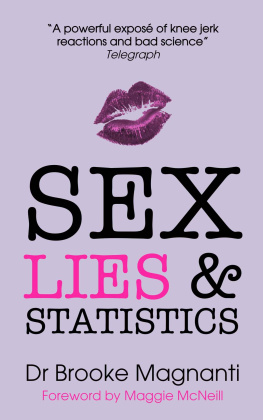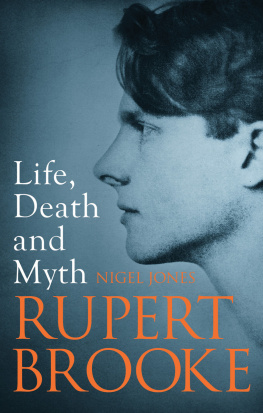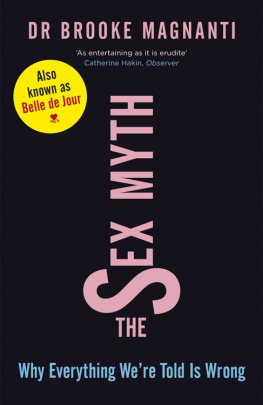Sex, Lies
& Statistics
BROOKE MAGNANTI
More books by this author
As Belle de Jour
Secret Diary of a London Call Girl
Further Adventures of a London Call Girl
Playing the Game
Belle de Jours Guide to Men
Belles Best Bits
As Brooke Magnanti
The Turning Tide
You Dont Know Me
Text copyright 2012, 2017 by Brooke Magnanti
All Rights Reserved
To everyone who tried to keep this book from being published.
You failed.
CONTENTS
Foreword to the US edition
by Maggie McNeill
Mark Twains witticism about statistics being the worst kind of lies is too familiar to need repeating. But while in his time it may have been a bit of an exaggeration for humorous effect, in ours it has become a plain fact. Ideologues who wish to lie convincingly have learned that fake statistics are very good at persuading the mathematically-illiterate to embrace ideas theyre already predisposed to believe.
That goes double when the subject is sex and quadruple when the subject is sex work; it seems that no figure, no matter how outlandish nor how blatantly in defiance of the laws of logic, psychology and physiology, is unbelievable to the average person as long as it serves to advance the narrative that sex is dirty and harmful, and that anyone involved in the sex industry must be either a victim or a villain.
If the subject were anything else, journalists (and perhaps even some politicians) faced with extreme claims involving many millions of people would almost certainly seek input from actual experts in the field. But due to the powerful and entrenched cultural stigmas surrounding sex, very few with the power to influence public opinion ever bother to consult sex workers about our own profession.
While there are many ethical academics who have produced sound research on sex work and sex in general, there are also many unethical ones who dont hesitate to craft bogus studies designed to produce false results intended to uphold an anti-sex agenda; how is a person with experience in neither science nor the sex industry to tell the difference?
Thats why social media have been such important tools in the advancement of sex workers rights; they have allowed sex workers to speak for ourselves despite the opposition of those with a vested interest in maintaining the status quo. Blogs and Twitter in particular have provided sex workers with a platform from which we can speak directly to the public, sharing our experiences and debunking the damned lies used by prohibitionists to raise and maintain public support for the criminalization of our work, lives and associates.
Unfortunately, the members of anti-sex crowd arent stupid; they can use social media as well, and theyre backed by authoritarian individuals, organizations and governments with very deep pockets. In the past 20 years an entire industry has grown up around convincing the voters that the sex workers who speak so eloquently about the harms done by criminalization are either lying, mentally ill, a tiny and unrepresentative minority, or all three. And one of their chief means of accomplishing this is the generation and dissemination of false facts and unsupported theories.
In the face of this assault, sex workers and ethical academics are faced with the daunting double task of not only getting the truth out, but also of debunking the myths and bogus statistics with which the prohibitionists hope to confuse and bamboozle those who dont have inside knowledge that comes from either deep study or lived experience.
That is why this book is so incredibly important. Dr. Brooke Magnanti is not only a former sex worker and an experienced activist with a broad, deep knowledge of the subject matter; she is also a trained scientist who can explain exactly how the anti-sex industry plays fast-and-loose with figures to make their lurid fantasies about sex, porn and sex work seem like sober facts in the eyes of those who dont know any better.
Dr. Magnanti has one more important credential: shes an engaging writer whose award-winning blog on her time as the London call girl Belle de Jour inspired several books and a hit television series, Secret Diary of a Call Girl. So even if math isnt your strong point, fear not; this book is written with the same style and wit that have made her a popular writer for over a decade, and strips away the dangerous nonsense the modern-day Puritans have used to cloak their moralistic crusade in the veneer of science.
Glossary
Sex work
Any job where sexual labour is the product or service. Here, I use sex work to refer mainly to full-service providers (prostitution) but porn, exotic dance and many other jobs are also kinds of sex work.
Sex worker
Someone who directly engages in sex work, whose erotic capital is the product or service. Porn directors and escort managers may be employed in the sex industry, but they are not sex workers per se.
Decriminalization/Decrim
The elimination of all legal impediments to sex work. As seen in eg. New Zealand and New South Wales Australia, where sex workers may choose to work in (regulated) premises for others or in private premises for themselves. The preferred model endorsed by sex worker-led organizations, Amnesty International, the WHO, UNAids, and many others because it aids labor rights and sex worker safety.
Legalization
A system where sex work is only permitted by regulated workers in licensed premises, such as Nevada's brothels or Amsterdam's Red Light District. Not preferred by sex worker-led organizations due to a "two tier" effect criminalizing some workers and not others.
Swedish model (or Nordic model), partial criminalization
A model where customers of sex workers are explicitly criminalized, as seen in Sweden, Norway, France and Northern Ireland. Not preferred by sex worker-led organizations due to indirect criminalization of sex workers, and increased danger and stigmatization.
Full criminalization
In most of the US and a number of other countries, both the buying and selling of sex are illegal, and stigmatizing sex workers is common.
introduction
Men, it has been well said, think in herds; it will be seen that they go mad in herds, while they only recover their senses slowly, and one by one.
Charles Mackay, Extraordinary Popular Delusions and the Madness of Crowds
When ancient cultures looked at the night sky they saw groups of stars, the way we do today. They drew imaginary lines between the stars to make pictures and tell stories. These pictures are known as constellations.
The stories behind constellations came with moral or cautionary undertones. One was the legend of the warrior Orion, placed among the heavens after his heroic death. Another was Cassiopeia, a vain queen suspended upside down in punishment for her self-obsession.
The pictures and the stories varied, depending on who was doing the looking. One of the most easily recognisable constellations is called the Big Dipper at least, its called that if you grew up in the US. In the UK they know it as the Plough. Ancient Greeks saw the constellation as the tail of a bear and called it Ursa Major. The same collection of stars is a cart to Scandinavians, a coffin in Arabia, and a group of sages according to Hindu astronomy.
From our perspective on Earth, the stars of that constellation seem inextricably linked and for most of human history we had no way of knowing otherwise. The truth is the stars in the Big Dipper are not close together at all. Its the angle we view them from that makes them look related. In fact, they vary from between 78 to 124 light years away. They are also moving apart in 50,000 years time the Big Dipper wont look at all how it does now.
Constellations are what you make when you look at something from a particular angle at a particular time. Ancient people stared at the night sky for so long the dots seemed to make pictures, so we joined them up. The names the constellations have been given by different cultures reflect preoccupations of the people naming them. And while the stories may be entertaining or send a value message, they tell us nothing about the nature of the stars in themselves. They do not tell us the truth.
Next page











